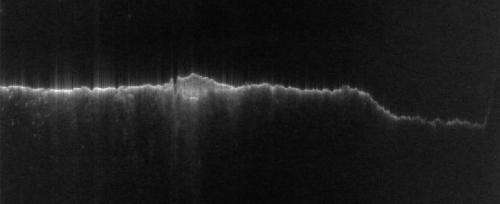Mars: What lies beneath

There is much more to Mars than meets the eye. By using the radar on Mars Express, we can see several kilometres below the surface to see what lies beneath.
The radar creates subsurface images of Mars by beaming low-frequency radio waves towards the planet, which are reflected from any surface they encounter.
While most are reflected by the planet's surface, some travel deeper and bounce off interfaces between layers of different material, such as between rock, water or ice.
The strength and timing of the radar echoes that arrive back at Mars Express are a gauge of the depths of different types of underground interfaces.
This radar image is a 5580 km-long slice through the southern highlands of Mars created shortly after the Mars Advanced Radar for Subsurface and Ionospheric Sounding instrument became operational in 2005.
The right-hand side is dominated by the vast Hellas Basin. It plunges 7 km below the surface and is about 2300 km wide, making it one of the largest impact basins in the Solar System.
The bright peak just left of centre is the south polar region of Mars. This is where the radar comes into its own, for beneath the cap of frozen carbon dioxide and water ice it reveals multiple layers of ice and dust.
Known as the South Polar Layered Deposits, this feature extends nearly 4 km below the surface. The layers are thought to arise from variations in the deposition of ice and dust as Mars experienced cycles of climate change.
Thanks to the radar, scientists have estimated that the amount of water trapped in frozen layers in the south polar region is equivalent to a liquid layer about 11 m deep covering the planet.
Provided by European Space Agency





















